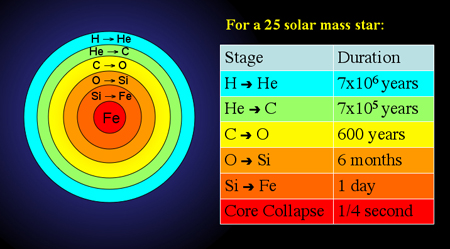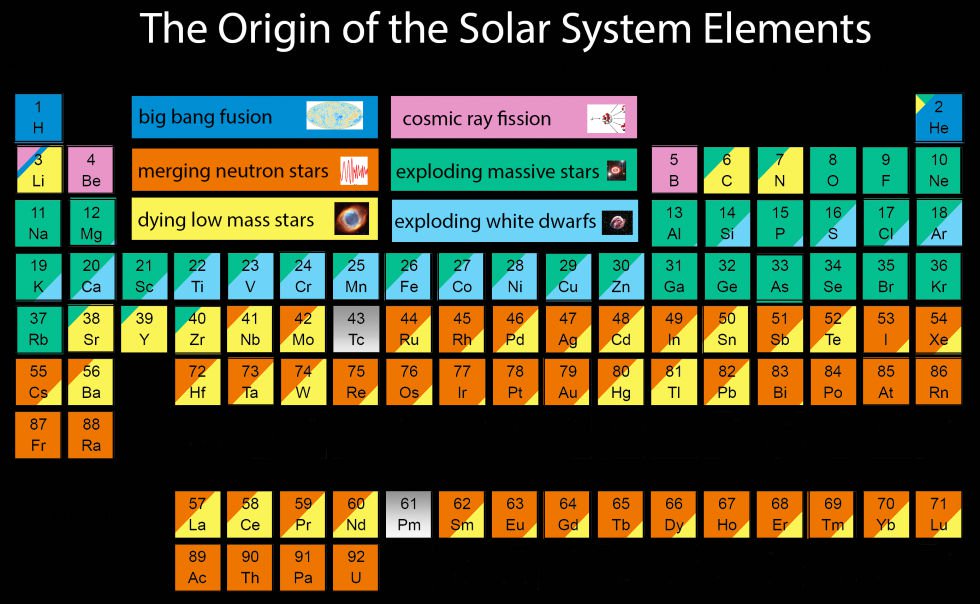A question about the star lifecycle.
Discussion
So said:
Homework question to which I cannot find a clear answer:
During what stage of a star's lifecycle are elements lighter than iron formed?
The question seems to suggest that there is a single stage, but I cannot find reference to it on the Internet.
Help appreciated please.
For a massive star, it will fuse elements lighter than iron during it's life prior to going supernova.During what stage of a star's lifecycle are elements lighter than iron formed?
The question seems to suggest that there is a single stage, but I cannot find reference to it on the Internet.
Help appreciated please.
A star will start fusing hydrogen into helium - then as the hydrogen runs low, the star will start fusing helium into carbon.....then it will fuse carbon etc.
What you end up with (if the star is suitably massive) is a star that has multiple shells in it's core made up of heavier and heavier elements.
As you go up the scale - the amount of energy released per fusion reaction is lower than the level before it. Eventually you get to iron which actually consumes energy in it's creation - the star can no longer sustain pressure in it's core - and it collapses. This is what we call a supernova. All elements heavier than iron are formed in this explosion.

Moonhawk said:
So said:
Homework question to which I cannot find a clear answer:
During what stage of a star's lifecycle are elements lighter than iron formed?
The question seems to suggest that there is a single stage, but I cannot find reference to it on the Internet.
Help appreciated please.
For a massive star, it will fuse elements lighter than iron during it's life prior to going supernova.During what stage of a star's lifecycle are elements lighter than iron formed?
The question seems to suggest that there is a single stage, but I cannot find reference to it on the Internet.
Help appreciated please.
A star will start fusing hydrogen into helium - then as the hydrogen runs low, the star will start fusing helium into carbon.....then it will fuse carbon etc.
What you end up with (if the star is suitably massive) is a star that has multiple shells in it's core made up of heavier and heavier elements.
As you go up the scale - the amount of energy released per fusion reaction is lower than the level before it. Eventually you get to iron which actually consumes energy in it's creation - the star can no longer sustain pressure in it's core - and it collapses. This is what we call a supernova. All elements heavier than iron are formed in this explosion.

So said:
So it's not at a single stage per se?
The majority of a star’s life is spent in a phase known as the ‘main sequence’.I suspect this is the single answer they are looking for.
https://en.m.wikipedia.org/wiki/Main_sequence
Most stars don't get to be supernovae. The life cycle of a star and the length of time it takes to go through that life cycle depends very much on the mass of the star. Smaller stars (which is most of them) simply sputter out when they have used up their fuel supply and got as far as the "iron" stage. They just cool down and become brown dwarves.
If they are large however, the higher gravitational forces at work continue to compress the mass beyond iron until there is a collapse resulting in a supernova. At that point, the massive energy created by this explosion creates much of the elements beyond iron and blasts them out into space.
If they are large however, the higher gravitational forces at work continue to compress the mass beyond iron until there is a collapse resulting in a supernova. At that point, the massive energy created by this explosion creates much of the elements beyond iron and blasts them out into space.
Eric Mc said:
Most stars don't get to be supernovae. The life cycle of a star and the length of time it takes to go through that life cycle depends very much on the mass of the star. Smaller stars (which is most of them) simply sputter out when they have used up their fuel supply and got as far as the "iron" stage. They just cool down and become brown dwarves.
Yep - hence why I stated "massive stars". Most main sequence stars will go through a red giant phase if they aren't massive enough to go supernova. At the end of the red giant phase - they gently puff off their outer atmosphere - leaving behind a white dwarf - which is essentially the exposed core of the former red giant (the puffed off atmosphere becomes a planetary nebula).
The question in the OP is somewhat ambiguous.
Whilst helium is formed during the main sequence - the majority of elements heavier than Helium (Carbon, Oxygen etc) are formed during the upper main sequence and later red giant phase - so the answer is technically both since all of these elements are lighter than Iron.
Edited by Moonhawk on Tuesday 12th June 08:05
Moonhawk said:
So said:
So it's not at a single stage per se?
The majority of a star’s life is spent in a phase known as the ‘main sequence’.I suspect this is the single answer they are looking for.
https://en.m.wikipedia.org/wiki/Main_sequence
So said:
Moonhawk said:
So said:
So it's not at a single stage per se?
The majority of a star’s life is spent in a phase known as the ‘main sequence’.I suspect this is the single answer they are looking for.
https://en.m.wikipedia.org/wiki/Main_sequence
So said:
Eric Mc said:
Stars are like people -
some are big,
some are small,
some live fast and die young, going out with a bang,
some are slow and live to great old age and just fade away
And some waffle on and on without addressing the question.some are big,
some are small,
some live fast and die young, going out with a bang,
some are slow and live to great old age and just fade away
The point I am making is that the life cycle of a star is not the same for all stars. How they progress through these cycles is very much dependent on their starting mass and to some extent that part of space they formed in i.e. the make up of the dust cloud that condensed to form them in the first place.
For example, stars that form near the centre of galaxies or in globular clusters tend to have a different make up to star that form out in the spiral arms of a galaxy.
Your original question indicated that you did not fully understood that stars were not completely uniform and that they don't all go through the exact same formation processes and life cycles.
The only stars that create substantial amounts of the elements heavier than iron are large stars that undergo supernova explosions. Most stars never get to that point.
Eric Mc said:
The only stars that create substantial amounts of the elements heavier than iron are large stars that undergo supernova explosions. Most stars never get to that point.
But the question was which stage of a star's lifecycle creates elements lighter than iron, not heavier.Hence why the question is somewhat ambiguous - since elements lighter than iron are formed in all stars (aside from brown dwarfs) at various stages of their life, through the main sequence and into the various sub-giant and giant phases depending on their mass.
Supernova is the cutoff between light element formation (<=Iron) and heavy element formation (>Iron)
Edited by Moonhawk on Tuesday 12th June 10:54
Moonhawk said:
Eric Mc said:
The only stars that create substantial amounts of the elements heavier than iron are large stars that undergo supernova explosions. Most stars never get to that point.
But the question was which stage of a star's lifecycle creates elements lighter than iron, not heavier.Hence why the question is somewhat ambiguous - since elements lighter than iron are formed in all stars (aside from brown dwarfs) at various stages of their life, through the main sequence and into the various sub-giant and giant phases depending on their mass.
Supernova is the cutoff between light element formation (<=Iron) and heavy element formation (>Iron)
Edited by Moonhawk on Tuesday 12th June 10:54
As you say, all elements up to iron will feature in the nuclear processes that go on in all stars. WHEN these processes happen depends on how big the star is.
Eric Mc said:
As you say, all elements up to iron will feature in the nuclear processes that go on in all stars. WHEN these processes happen depends on how big the star is.
Hydrogen fusion into helium always occurs in the main sequence - it's pretty much the definition of what constitutes a main sequence star.That's why I suggested it as the most likely single answer. Where stars go once they exit the main sequence can vary dependent on mass - although most do end up as red giants.
Edited by Moonhawk on Tuesday 12th June 11:20
Moonhawk said:
Eric Mc said:
As you say, all elements up to iron will feature in the nuclear processes that go on in all stars. WHEN these processes happen depends on how big the star is.
Hydrogen fusion into helium always occurs in the main sequence - it's pretty much the definition of what constitutes a main sequence star.Stars tend to start with masses of hydrogen and, for most of its life, being a star means that hydrogen/helium fusion is what is going on in its core. The bigger the mass, the more rapidly it burns through its hydrogen bank and switches over to fusing helium to carbon. Next up is carbon to oxygen and so on down the chain until you get to iron.
For smaller stars, that is where it stops.
For larger stars, a supernova explosion will fuse elements heavier than iron.
In reality, there are other fusion processes that might go in in a star at the same time as some of the above because stars, especially in their later lives, become more complex with different shells of matter at differing temperatures which will allow different fusion processes to go on at the same time depending on the temperature and mass in any given shell of material.
Toltec said:
Pretty cool that they are covering this subject at school now, is 'A' level physics or can you do astronomy/astrophysics now? While I knew some of it already stellar structure was not covered formally until the first year at uni.
It’s cool unless your father has zero interest in or knowledge of astronomy. I am also not sure that it’s cool to set it as a question for an 11 year old, when he hasn’t studied it. Especially as it is an online test where you cannot progress to the next question without answering the previous one.Thanks for the attempts at educating me though chaps, I have messaged him with your comments and the most probable answer. I’ve suggested he should discuss it with his physics teacher.
Gassing Station | Science! | Top of Page | What's New | My Stuff





